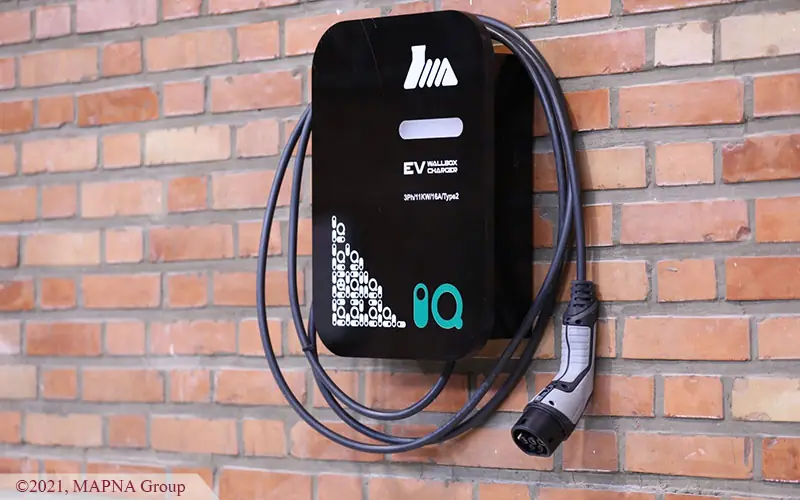MAPNA Group’s Electric Vehicle and Infrastructure Development Center is to unveil the latest generation of its indigenized home electric vehicle chargers, which will come with new functions and a fresh style.
The newly-designed home chargers are smart systems, which can recharge EV batteries round the clock with a regulated flow depending on input current and peak hours.
Given the time involved in charging EVs, many owners prefer to charge their vehicles in places where they park for a long time instead of waiting in stations. Thus, homes, apartments, and workplaces are prime locations where MAPNA’s new chargers can be installed and commissioned.
Based on latest data, Iranian drivers travel an average of 50 kilometers per day on urban routes. Such mileage does not exceed even 30% of the trip an electric vehicle can go with a 50kWh battery; this means, charging an EV twice a week, will help meet the major needs of consumers in the country.
Furthermore, ride hailing vehicles average 200 kilometers each day, which is the same distance that modern EVs can go on a single charge. In other words, ride hailing drivers’ needs can be totally covered with each charge, and they may simply obtain their batteries filled at home with proper planning.
Simply put, home charging is low-cost, safe, and convenient, and can benefit all EV drivers, thus increasing the green means of transportation.
Manufacturers have offered home AC chargers to help realize this dream, with most electric car owners now having a wall charger in their garages.

AC chargers, coming in wall models, are on top of the product portfolios of all EV charger manufacturers.
In Iran, home chargers are provided by MAPNA Group and its subsidiary, MAPNA Electric Vehicle and Infrastructure Development Center – the country’s flagship producer of EV chargers. MAPNA’s new home chargers can fill up EV batteries at night, while letting vehicles that have been left uncharged during the day be charged at a slower rate (depending on input current and peak hours).
The charging time of an electric vehicle is determined by various factors:
Battery size/capacity: The larger the EV battery, the longer it will take to recharge.
Discharge capacity of home stations: The compatibility of the electric vehicle charging system and chargers is critical. If an EV battery can handle a high-voltage input while home charger has a limited discharge capacity, it will take a long time to recharge.
EV charger voltage capacity: Level 2 EV chargers work within a range of 220V-240V. EVs need to have the capacity to receive this level of input.
Environmental factors: A battery that is either too cold or too hot might limit the maximum power consumption and, as a result, affect the charging time.
Among these factors, the charging time of an electric car is determined by the power supply and the EV’s battery capacity.
This indicates that if an electric car has a 6.6 kW charger and a 50kWh battery, it will take around 8 hours to charge a totally drained battery. Moreover, it suggests that if we install one of the level 2 chargers in our home, the station will be able to provide 7.74 kW of power.
MAPNA home chargers come with mobile applications. This EV owners to monitor the charging status of the car at any time. Drivers can pause or resume the charging process whether the vehicle is charging at home or at work. EVs can go 30 kilometers per every hour of charging, therefore with a 2-hour charging at MAPNA’s home stations, we can drive more than 50 kilometers.
MAPNA home chargers are available with a Type 1 output connector (similar to the Mitsubishi Outlander PHEV) or a Type 2 output connector (similar to the Nissan Leaf or BMW I8), and cable lengths of 5 meters or 7 meters are available depending on customer requirements.
The following are the key characteristics of MAPNA chargers:
Wide power range: These chargers are available in 3.7-, 7.4- and 22-kW capacities depending on the input power and meter.
Private or shared use: The control system of these chargers can be connected to building BMS, allowing it to be installed and used jointly or individually.
Master-slave: In this case, one of the chargers is in charge of monitoring and managing other chargers in a building; that is, the building manager can oversee each EV’s usage and share of the bills via the Master charger.
Smart Application: These chargers use the OCPP 1.6 communication protocol to connect with the MAPNA Control and Monitoring Center. The chargers can be remotely monitored and troubleshooted with this feature. Controlling user consumption during peak hours is another advantage of these smart systems. The chargers are thus configured to be out of circuit during peak hours, preventing the electric vehicle from being charged. In other words, the input current is intelligently regulated by the upstream center during peak hours. For example, a car that requires 32 amps of input is temporarily charged with a lower current, such as 8 amps, during the peak hours.
Electric cars usher in a new era of travel that is both easier and less expensive.
Please visit https://www.mapna-evidc.com for more information.
The Earth is Breathing.
MAPNA Group’s Electric Vehicle and Infrastructure Development Center

